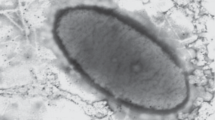Abstract
Sixty-two aerobic bacterial strains isolated from the unproductive dystrophic Lake Skärshultsjön (South Sweden) were screened for plasmids. The lake is considered to be an extreme environment because of its high concentration of persistent but nontoxic humic compounds. One-third of the isolates harbored multiple plasmids usually of similar high molecular weights (>25 Mdal). The plasmid-bearing strains were members of the common aquatic taxaPseudomonas spp.,Acinetobacter sp.,Alcaligenes sp.,Aeromonas/Vibrio group, andEnterobacteriaceae (taxonomy is tentative). The majority of isolates displayed multiple resistance to antibiotics and heavy metals. Some of them were capable of degrading aromatic compounds. Three isolates were chosen for curing experiments. Only strain S-68, anAlcaligenes sp., could be cured of one of its two plasmids. It harbored the two cryptic plasmids pQQ32 and pQQ70 of 32 and ca. 70 Mdal, and the latter was segregated during ethidium bromide treatment. Parental strain S-68 was capable of degrading some of nonchlorinated phenolic compounds and displayed resistance to a broad spectrum of antibiotics and the heavy metals Co2+, Ni2+, Zn2+, Cd2+, and Hg2+. Derivative strain S-68-41 lost its resistance to nickel, suggesting segregated plasmid PQQ70 coded for nickel resistance. Transformation experiments to restore nickel resistance in the cured derivative strain were not successful.
Access this article
We’re sorry, something doesn't seem to be working properly.
Please try refreshing the page. If that doesn't work, please contact support so we can address the problem.
Similar content being viewed by others
References
Anderson DG, McKay LL (1983) Simple and rapid method for isolating large plasmid DNA from lactic streptococci. Appl Environ Microbiol 46:549–552
Anderson ES (1966) Possible importance of transfer factors in bacterial evolution. Nature 209: 637–638
Andersson G (1980) Lagtidsmässiga föränderingar i smålandska sjöars vattenkemi. Institute of Limnology, University of Lund, Sweden
Babich H, Stotzky G (1983) Toxicity of nickel to microbes: Environmental aspects. Adv Appl Microbiol 29:195–265
Bergey's Manual of Systematic Bacteriology (1984) Krieg NR, Holt JG (eds) Vol. 1. The Williams & Wilkens Comp, Baltimore
Broda P (1979) Plasmids. Freeman and Company, Oxford
Burton NF, Day MJ, Bull AT (1982) Distribution of bacterial plasmids in clean and polluted site in a South Wales river. Appl Environ Microbiol 44:1026–1029
Chatterjee DK, Chakrabarty AM (1984) Restriction mapping of a chlorobenzoate degrading Plasmid and molecular cloning of the degradative genes. Gene 27:173–181
Davies J, Smith DI (1978) Plasmid-determined resistance to antimicrobial agents. Ann Rev Microbiol 32:469–518
De Vos G, De Beuckeleer M, Van Montagu M, Schell J (1981) Restriction endonuclease mapping of the octopine tumor-inducing plasmid pTiAch5 ofAgrobacterium tumefaciens. Plasmid 6:249–253
Don RH, Pemberton JM (1981) Properties of six pesticide degradation plasmids fromAlcaligenes paradoxus andAlcaligenes eutrophus. J Bacteriol 145:681–686
Ericsson HM (1960) Rational use of antibiotics in hospitals. Scand J Clin & Invest 12:1–50
Ferguson LR, MacPhee DG (1984) Frameshift mutagenesis by acridines in wild-type uvrB and polA strains ofSalmonella typhimurium with and without plasmid pKM101. Mutation Research 141:83–88
Foster TJ (1983) Plasmid-determined resistance to antibiotics and toxic heavy metal ions in bacteria. Microbiol Rev 47:361–409
Friedrich B, Meyer M, Schlegel HG (1983) Transfer of expression of the herbicide-degrading plasmid pJP4 in aerobic autotrophic bacteria. Arch Microbiol 134:92–97
Gjessing ET (1976) Physical and chemical characteristics of aquatic humus. Ann Arbor Science Publ Inc, Ann Arbor
Glassman DL, McNicol LA (1981) Plasmid frequency in natural populations of estuarine microorganisms. Plasmid 5:231
Hada HS, Sizemore RK (1981) Incidence of plasmids in marineVibrio spp. isolated from an oil field in the northwestern Gulf of Mexico. Appl Environ Microbiol 41:199–202
Harwood CR (1980) Plasmids. In: Goodfellow, M, Board RG (eds) Microbial classification and identification. Academic Press, London, 27–53
Hausinger RP (1987) Nickel utilization by microorganisms. Microbiol Rev 51:22–42
Kobori H, Sullivan CW, Shizuya H (1984) Bacterial plasmids in antarctic microbial assemblages. Appl Environ Microbiol 48:515–518
Maniatis T, Fritsch EF, Sambrook J (1982) Molecular cloning. A laboratory manual. Cold Spring Harbor Laboratory, New York
Mergeay M, Nies D, Schlegel HG, Gerits J, Charles P, Van Gijsegem F (1985)Alcaligenes eutrophus CH34 is a facultative chemolithotroph with plasmid-bound resistance to heavy metals. J Bacteriol 162:328–334
Moaledj K (1984) Über schnelle miniaturisierte Bestimmungsverfahren für Bakterienpopulationen in aquatischen Ökosystemen. Arch Hydrobiol 100:99–121
Olson BH, Barkay T, Colwell RR (1979) Role of plasmids in mercury transformation by bacteria isolated from aquatic environment. Appl Environ Microbiol 38:478–485
Overbeck J (1965) Über Anreicherung und Isolierung methanoxidierender Bakterien aus dem Süßwasser. Zbl Bakt I Abt/Suppl 1:139–147
Reanney DC (1978) Genetic engineering as an adaptive strategy. Brookhaven Symposia in Biology 29:248–271
Roszak DB, Colwell RR (1987) Survival strategies in the natural environment. Microbial Reviews 51:365–379
Schleif RF, Wensink PC (1981) Practical methods in molecular biology. Springer Verlag, New York
Schütt C (1988) Plasmid-DNA in natural bacterial populations of four brownwater lakes (South Sweden). Arch Hydrobiol Beih 31:133–139
Schütt C (1988) Habitat-specific plasmid patterns in natural bacterial populations of freshwater lakes. Verh Internat Verein Limnol (in press)
Schütt C, Zelibor JL, Colwell RR (1986) Role of bacterial plasmids in manganese oxidation: Evidence for plasmid-encoded heavy metal resistance. Geomicrobiology 4:389–406
Sizemore RK, Colwell RR (1977) Plasmids carried by antibiotic resistant marine bacteria. Antimicrob Agents Chemother 12:372–382
Slater JH (1984) Genetic interactions in microbial communities. In: Klug MJ, Reddy CA (eds) Current Perspectives in Microbial Ecology. Am Soc Microbiol, Washington, DC 87–93
Smith DH (1967) R factors mediate resistance to mercury, nickel and cobalt. Science 156: 1114–1116
Author information
Authors and Affiliations
Rights and permissions
About this article
Cite this article
Schütt, C. Plasmids in the bacterial assemblage of a dystrophic Lake: Evidence for plasmid-encoded nickel resistance. Microb Ecol 17, 49–62 (1989). https://doi.org/10.1007/BF02025593
Issue Date:
DOI: https://doi.org/10.1007/BF02025593




